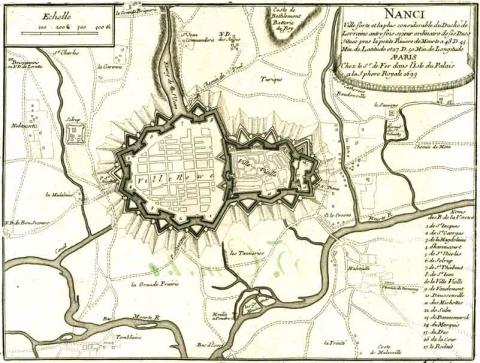Nancy
History and description
A town of medieval origins, the Old Town (Vieille Ville) of Nancy had its first city fortifications built in around the 11th century. These medieval ramparts were repaired multiple times before finally being replaced by a bastioned urban wall from 1550. This urban wall included eight orillon bastions, a ravelin and two gates. Around 1580, the Duke of Lorraine, Charles III decided to expand his capital. The New Town (Ville Neuve) was constructed to the south-east of the Old Town and surrounded by its own bastioned urban wall, in a hemispherical shape and including eight fronts and eight bastions. An arsenal and a barracks were also constructed. Italian engineers, including J. B. Stabili, were behind the design of these ramparts. The urbanization got underway in 1588, according to an orthogonal plan, the route of which was based on those already existing and without any link to the route of the new fortifications. The Old Town remained separated from the New Town by the urban wall of 1550. Only the porte Saint-Nicolas allowed communication between the two towns. The town-planning of the New Town only got underway in 1603, the Duke having preferred to establish gardens in the Old Town first. A pentagonal citadel was to have been constructed near to Nancy but the project was never realised, even though a provisional construction was to have been remodelled by the French during the Thirty Years war. Throughout the 17th century, the urbanisation of the New Town continued and included, among other things, the construction of numerous convents, two provisional churches and a cathedral, the construction of which started in 1670 and continued for a century. The eglise paroissiale Saint-Sébastien (Saint-Sébastien parish church) would not emerge until the 18th century.The urban wall of the New Town disappeared in 1661, razed to the ground by the French. For ten years, only the Old Town remained fortified. Vauban reconstructed the urban wall of the new district from 1671, foreseeing the War of Holland. However, this second urban wall of the New Town was demolished in 1698, when the treaty of Rijswick of 1697 was applied, signalling the end of the war of the League of Augsbourg and the restoration of Duchy of Lorraine. The urban wall of the Old Town was razed to the ground from 1750 and replaced by tree-lined avenues, on the orders of Duke Stanislas, father-in-law of Louis XV and ex-King of Poland. The three squares of the Duke, namely place Saint-Stanislas, place Carrière and place Neuve today retrace the site of the rampart, which used to separate the two towns. A barracks, today known as the caserne Thiry, was constructed from 1764 to 1769.
Current state
Little still remains of the ramparts of Nancy. Seven gates of the urban wall have been preserved. The two initial examples are the porte médiévale de la Craffe (medieval Craffe gate) and its equivalent of the 17th century, the porte Notre-Dame. These were followed by the porte Saint-Georges, the porte de la Forteresse and the porte Saint-Nicolas, constructed from the 16th to the 17th century. The final two were the porte Saint-Stanislas and the porte Sainte-Catherine, dating from the 18th century. The remains of a bastion are visible in the basement of the musée des Beaux Arts (Fine Arts museum). The arsenal of the Renaissance and the caserne Thiry are also preserved.
Nancy
Nancy
48° 41' 37" N, 6° 11' 5" E
Type
urban wall
Engineers
Jean-Baptiste Stabili, Sébastien le Prestre de Vauban
Department
Meurthe-et-Moselle
Region
Grand Est
Bibliography
- DE ROUX (A.), Villes neuves, urbanisme classique, Paris, 1997, p. 100-107.
- DUMONTIER (M.), « Vauban à Nancy » in Le Pays lorrain, s. l., n°4, 1953, p. 135-145.

